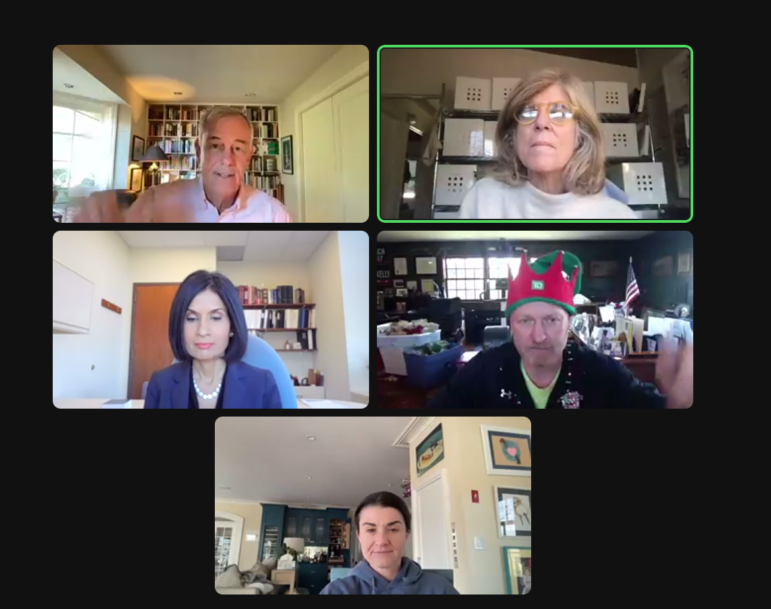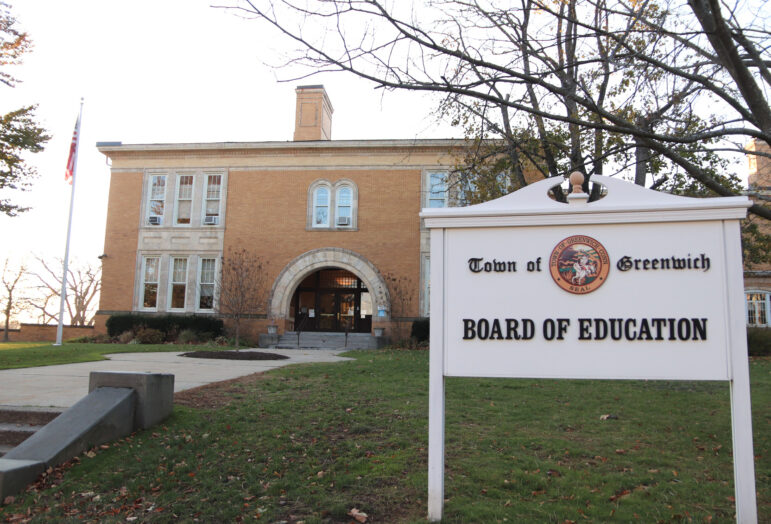On Tuesday the Advisory Committee on the Havemeyer Building appointed by First Selectman Fred Camillo met for a second time.
Chair Republican Andy Duus confirmed the six members include himself, Joe Kelly (R), Bill Drake (R), Christina Downey (D), Miriam Kreuzer (D), and architect Amy Courage.

The committee talked about constraints on the use of the building and use of funds in the trust established to maintain it.
Aamina Ahmad from the town Law Department said the Greenwich Public Schools administration, who have their offices inside the Havemeyer building, had not tapped the fund in at least a decade.
Another potential constraint is that the building is in the Greenwich Avenue Historic District.
Mr. Duus said he had spoken to Mike Harris, a retired partner of Ivey Barnum & O’Mara, who still serves as trustee, along with Pat Burns, and learned that the current trust balance was $673,000, which he described as not trivial.
Ms Ahmad said a title search had previously been done, but was being reviewed by her office.
She said her office had previously researched the use of the building and potential restrictions back when the non-profit Greenwich Center for the Arts sought to convert the facility to an arts center in 2007-2008.
The main restriction on the building and its use is connected to the Havemeyer trust fund created in 1909.
“The trust fund is quite clear in that says in the case of the destruction or abandonment of the school building, or neglect or refusal of the authorities to continue its use as intended by Henry Havemeyer, the funds that are in that trust fund will essentially revert back to the heirs of Mr. Havemeyer.”
“The trust document itself doesn’t get into this issue of the use of the building independent of the trust fund,” Ahmad continued. “If this committee and the town, with input from the BOE, decide the administration will move out of the building and the building will be put to a use other than for school purposes, then we know…that the monies currently there, $673,000, will no longer be available….”
She said today the fund could be tapped for renovations or repairs.
Ms Ahmad said her department had been unable to find any type of gift document or agreement that came with the gift of the building.
The language in the trust refers only to “school purposes.”
Christina Downey asked who actually owned the building, noting that the original deed from Daniel Mead granted the property to the Meeting House School District.

Ahmad explained that over the years there had been state legislation mandating that individual school districts be consolidated into municipalities.
“Those properties then essentially became properties of the municipality,” Ahmad said.
She mentioned a book by attorney Tom Mooney, A Practical Guide to Connecticut School Law that references these topics.
She said General Statute 10-220 says BOEs “shall have the care, maintenance and operation of buildings, lands, apparatus and other property used for school purposes….”
She said if the committee and other stakeholders in town decided to move the administration out of the building and use it for something unrelated to school purposes, the BOE would need to take a vote.
“But the ownership of the building has been and remains in the town,” she said.
“Once it’s out of the BOE’s purview, in that sense, then the town and this committee can then decide how you wish to proceed with the building itself,” she added.
“Any repurposing of the building would have to be reviewed and voted on by the board?” Ms Downey asked.
“Correct, right,” Ahmad said.
“So we have squatter’s rights,” Joe Kelly commented.
Mr. Kelly asked about using the existing $637,000 on improvements and “cleaning up” and avoid giving it back to the Havemeyer heirs prior to making any decision about the future use of the building.
Mr. Duus said he’d discussed qualifying expenditures with the trustee, Mr. Harris.
The trust agreement refers to keeping in good order and repair the school building and fixtures.
“It doesn’t mean it would exclude a capital expenditure,” Mr. Duus said. “Capital expenditures are also designed to keep the building in good order.”
“I’ve asked him to clarify. He hasn’t had much practice in the past 10 years in answering these questions because there haven’t been draw downs in the past decade,” Mr. Duus said.
Ms Ahmad said she’d learned that the last time the funds were tapped was by then assistant superintendent Susan Wallerstein for repair work at the building.
Mr. Kelly said he would reach out to the district’s facilities director Dan Watson and talk about identifying work that needed to be done at the building.
Mr. Duus said it was also a question for the trustees whether money spent on repairs that did not tap into the fund could be “clawed back.”
Miriam Kreuzer asked how open-ended the “school uses” use was. She noted local non profits such as the Greenwich Alliance for Education and the Family Centers supplement education of children in town.
Ms Ahmad said back when the administration was moved into the building in 1971, the question of school use had been asked.
“We’d have to look at that very closely if we want to continue to tap into the trust fund,” Ahmad said, adding that a letter from 1971 described a similar situation over the decision to put the administration in the building, and not house students there, and whether the trust fund was part of the equation and the answer was yes.”
“We have to establish who has authority over the money because we don’t want to be stepping on any toes,” Kelly said. “If different groups want to use money in the trust, does any group have authority over another group, or is it at the discretion of the trustees?”
He asked Ms Ahmad what would happen if, for example, the BET and BOE had conflicting interests in the use of the trust funds.
Ms Ahmad said her understanding was that would be a question for the trustees.
She noted that during discussion of intersection improvements the previous night at the RTM there was a great deal of focus during on the history and character of Greenwich Ave in the area of Havemeyer. She noted it was a historic building within a historic district.
“There certainly is room to work within the confines of the history and spirit of the area. I would recommend when you get to that point to engage with all the stakeholders,” Ahmad said.
The committee discussed the suggestion to invite Stuart Adelberg and Peter Malkin, who had championed the Greenwich Center for the Arts in 2008, to share their experiences with this committee.
Lastly, they discussed scheduling a tour of the building in January, which would technically be a public meeting.
See also:
Special Committee to Evaluate Options for Future Use of Historic Havemeyer Building
November 28, 2022